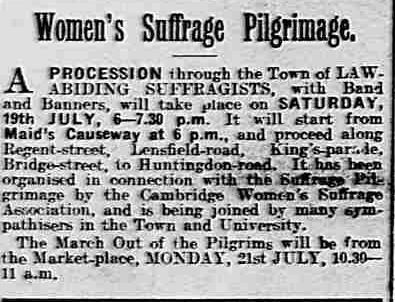Dr Gill Sutherland, Newnham College, gave a fascinating and authoritative talk about Millicent Garrett Fawcett at the Local History Group meeting on 10 May 2018. Meeting report by Andrew Roberts, with thanks to Dr Sutherland for permission to summarise her talk and use some of her images. There are also pages with notes about Millicent Fawcett and the life of Henry Fawcett.
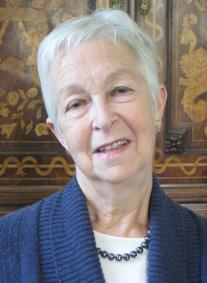
‘Hold fast, hold firm, hold OUT’
Dr Sutherland opened her talk by thanking her colleagues at Newnham College and The Women’s Library (London School of Economics) for advice and images.
Gill said that the primary purpose of her talk was to celebrate Millicent Garrett Fawcett, who had for so long been the public face of the non-violent campaign for women’s suffrage. She had recently been honoured by the first statue of a woman in Parliament Square, which is enormously impressive. In addition to portraying Millicent Fawcett, the statue by Gillian Wearing has images of other campaigners set in the plinth. The statue carries a placard with the words ‘Courage calls to courage everywhere’, spoken by Millicent Fawcett after the death of Emily Wilding Davison.
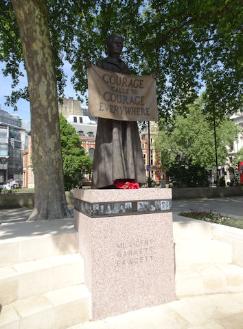
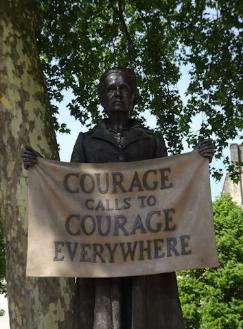
‘Hold fast, hold firm, hold OUT’ were also Millicent Fawcett’s words, which Gill said she had chosen for the title of her talk because they convey so much about the campaign for votes for women. Millicent had been a supporter of votes for women since childhood, a campaign that came into focus in 1866 when supporters added their signatures to a petition asking Parliament to enfranchise women householders. Gill stressed that it took another 52 years before some women gained the right to vote in Parliamentary elections. There were phases of campaigning, setbacks and disappointments during the process. Millicent’s career represented a master class in peaceful campaigning.
Millicent Garrett was born in 1847, one of 11 children of Newson Garrett and Louisa Dunnell. Newson Garrett was a corn merchant, chandler and brewer, and the family lived in Snape, London and Aldeburgh. Three Garrett sisters became remarkably successful, with the support of their parents: Millicent, Elizabeth Garrett Anderson, who had an acclaimed medical career, and Agnes Garrett, who set up a successful interior design business with her cousin, Rhoda Garrett.
In 1867, Millicent Garrett married Henry Fawcett, the blind radical liberal politician, who was MP for Brighton and Professor of Political Economy at Cambridge. They spent six months of each year in London and six in Cambridge, at first renting. They bought the house at 18 Brookside, Cambridge, in 1875. Gill mentioned the blue plaque to Millicent that had recently been placed there, above the earlier plaque to Henry.
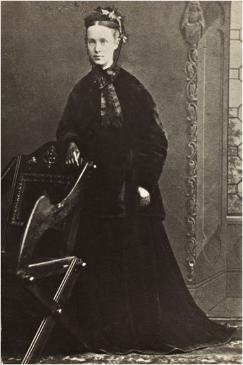
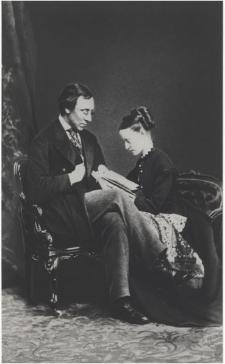
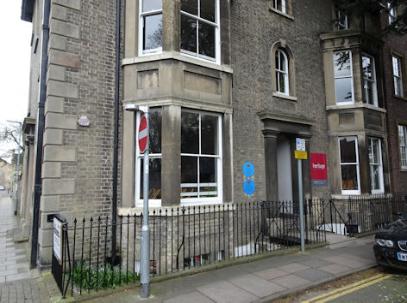
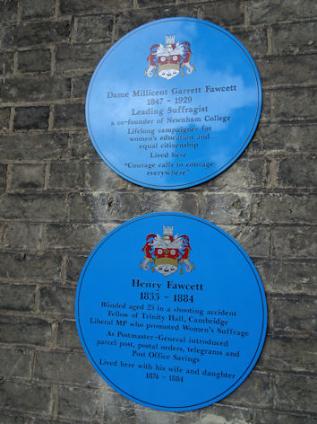
Millicent and Henry had a daughter, Philippa, in 1868. Gill said that Millicent became the eyes of Henry, reading for and with him, writing, speaking with him on public platforms and gaining an intensive political education. Millicent was tiny, well dressed, with a mass of auburn hair, while Henry was exceedingly tall.
In Cambridge, they worked together on a campaign for higher education for women, supporting a programme of lectures for ladies. Millicent worked with the community of dons’ wives to ensure their support. As the lecture series developed, the group realised that some residential accommodation would be needed and Millicent encouraged Henry Sidgwick to lease a house to accommodate five students, the beginning of what became Newnham College. After a few years, the committee leased land on which to build Newnham Hall, 1875. The committee became a limited not-for-profit company in 1881, turning into a College, a self-governing academic community, with a Charter and Statutes in 1917. Millicent served on the Council of the Newnham Hall Company from 1881 to 1909.
By 1881, London was increasingly the family base, with Henry a government minister and Philippa at secondary school. Gill said that Henry was ill in 1882 and then in 1884 he had pneumonia which put a strain on his heart. Henry died, leaving Millicent a widow at the age of 37. He was buried at Trumpington Church, and a window was installed in the Church in his memory.
Gill said that Millicent established a new pattern of life after a period of grief.
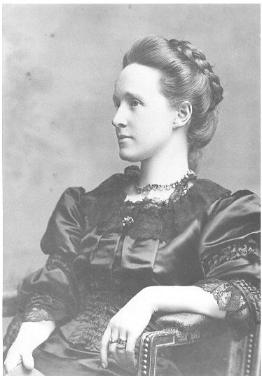
Millicent and Phillipa moved to live with her sister Agnes at 2 Gower Street, London. Rhoda Garrett had died, leaving Agnes to continue the interior design firm. The two sisters continued their commitment to the suffrage cause. In 1887, Philippa went to Newnham College to study mathematics, topping the mathematical tripos in 1890, and later being appointed a lecturer at Newnham.
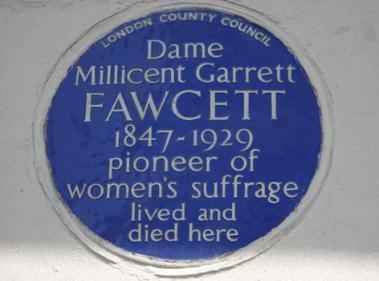
Gill said that the suffrage campaign became the centre of Millicent’s life. In the 1880s, the National Union of Women’s Suffrage Societies (NUWSS) was a loose federation and it remained so until the 1900s. It established a more discipline structure by 1907 and Millicent was elected President. In 1903, Emmeline Pankhurst had launched the Women’s Social and Political Union (WSPU), moving to militancy from 1905, leading to the rough treatment of members, ejection from meetings and short periods in prison. Initially, Millicent was supportive and deplored the violence shown to the protesters but as the militancy led to attacks on property in which people were sometimes also caught up, the NUWSS distanced itself from the WSPU, with a total separation from late 1909.
The NUWSS organised a great march in 1908, when the students of Newnham and Girton made and carried a banner, used again in subsequent processions and now held at Newnham. In the 1908 march, women moved in eight blocks according to their professions. There were patronising and dismissive male comments about the march and Millicent herself, but the women insisted on their professional standing.
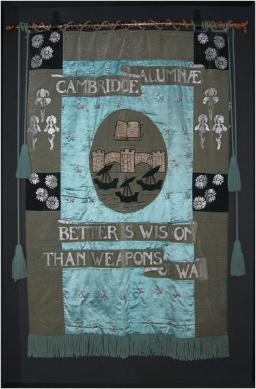
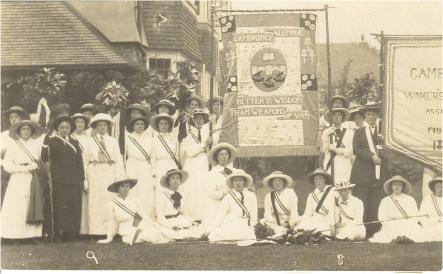
There were other peaceful processions, including a pilgrimage caravan from different parts of the country to London in 1913. Gill explained that the NUWSS was very effective at fundraising, producing a weekly journal with a circulation of 12,000 in 1912, having 32 full-time paid organisers and 52,000 members in 1913 and over 600 affiliated branches and societies in 1914. The NUWSS adopted the colours of red, green and white.
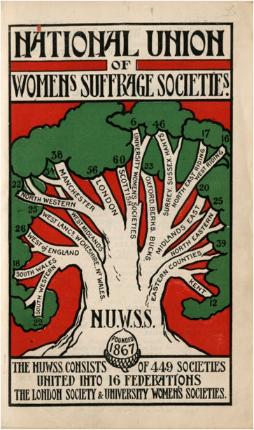
By 1913, the NUWSS recognised that the Liberal party would not give women the vote and began making approaches to the Labour party. The start of the 1914 War led to a crisis within the organisation, with conflicting interests including patriotism and pacificism. Gill said that Millicent thought it would be a disaster if the movement failed to give its full energy to the war effort and this became the public position of the NUWSS. As a result, the movement supported refugees, women workers, activity by local councils and medical commitments such as units of the Scottish Women’s Hospitals Group (SWHG). The students of Newnham and Girton supported their work and a number went to work for them after completing their courses. The SWHG worked in Russia (until the 1917 revolution) and on the Eastern Front. Gill noted that there were few memorials to the role of women in the War.
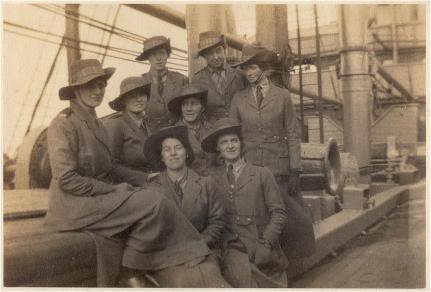
Gill described how the pressure for suffrage continued during the War, but a Speaker’s Conference in 1916 resulted in the recognition of the case for the full franchise for men. When Lloyd George became Prime Minister in December 1916, it was hoped that the change would carry women forward as well, but the proposal was for votes for all males over 21 and women over 30 with property owning and educational qualifications. Gill said that women felt it was highly offensive that women were not regarded as grown up at 21 to justify the vote but Millicent’s response was pragmatic. The draft bill was published in 1917 and received Royal Assent on 6 February 1918, with the NUWSS organising a victory celebration.
In 1918, Millicent was now 70 years old. Gill said that Millicent looked benign but was extremely tough. She managed her own correspondence, travelled alone and had legendary self control. After standing down from the Presidency of the NUWSS, she travelled widely, usually with Agnes, including Palestine, the Far East. She was awarded honorary degrees and made a DBE in 1925. There is a portrait of her in the 1920s in the Newnham Senior Common Room, in the robes of an honorary doctorate from St Andrews and wearing a pendant in the NUWSS colours given to her by the NUWSS in 1913.
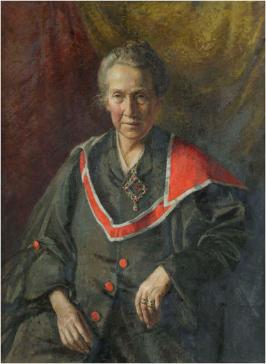
Gill said that Millicent Fawcett continued to battle for education, advising the Cambridge women who hoped to use the first provision of public funding for Oxford and Cambridge as a lever to improve the position of women in the University. In 1928, she shared a platform with Emmeline Pankhurst when a further Representation of the People Bill, at last giving women the vote on the same terms as men, was under discussion. She celebrated the Royal Assent on 2 July 1928.
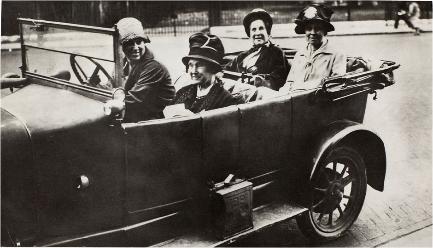
Millicent Fawcett died on 5 August 1929. There is a bronze memorial to Henry and Millicent Fawcett in St George’s Chapel, Westminster Abbey, with roundels added in memory of Millicent in 1932. The inscription reads ” Dame Millicent Garrett Fawcett 1847-1929. A wise constant and courageous Englishwoman. She won citizenship for Women”.
Questions asked at the meeting on 10 May 2018
Q: I had not realised there were militant and non-militant movements. Which took the credit for the 1918 Act?
A: Everyone should have credit, it is not fruitful to weigh the contributions. The NUWSS skills and resources were mobilised very effectively during the War and this outweighed the role of the WSPU which was more top heavy. In the late 1920s, Emmeline Pankhurst stood as a Conservative candidate. The activities of the WSPU militants made the NUWSS caravans, etc., a target for objection.
Q: How did women become influential in politics?
A: Women increasingly had the vote and an involvement in local government from the 1870s. They were increasingly influential and cut their teeth at the local level as social issues, the education system and the poor law became more important, and as these became national concerns.
Q: Did the pilgrimage come through Cambridge.
A: I do not know, but would be surprised if it did not. (See below, the pilgrimage did come through Cambridge in July 1913.)
Q: Voting rights at the local level?
A: Voting rights were acquired incrementally, with school boards after the 1870 Education Act, to County Councils in 1888 and Parish Councils in 1894. Women were firmly embedded in local government.
Q: It is interesting to hear about the Scottish Women’s Hospital Units, presumably there were no similar ventures in England and Wales?
A: The Scottish Women’s Hospital Units were well organised, there were many women in medical training in Scotland but they also recruited from across the country. The British Army would not allow the units to work at the Front in France, even though the French and Belgium governments did. The British Army did send convalescents to the hospital in Endell Street in London run entirely by women and headed by Louisa Garrett Anderson, Millicent’s niece and Elizabeth’s daughter.
Q: What were the arguments for not giving women the vote?
A: It was claimed that women could not be trusted to handle the vote effectively, particularly with foreign affairs.
Q: Was the NUWSS only middle class?
A: The NUWSS had very solid working class representation, for example in the Women’s Textile Unions in the north west, but was more middle class in Cambridge.
Q from Gill Sutherland: Why was Henry Fawcett buried in Trumpington, what was the initiative behind that and the window in the Church?
A from Wendy Roberts: at the time of Henry’s burial, it was reported in the local newspaper that it was understood that Henry had given instructions in his will that if he died in London he was to be buried in Salisbury whereas if he died in Cambridge he was to be buried in Trumpington. Howard Slatter added that we were not aware of any record of him attending Trumpington Church. (See the report on the funeral.)
Suffrage pilgrimage, July 1913
In the Cambridge Independent Press, 30 May 1913, there was an item about a planning meeting having been held to discuss and assist the women’s pilgrimage being organised by the National Union of Women’s Suffrage Societies, which aimed to arrive at Hyde Park, London, on Saturday 26 July. In the Cambridge Independent Press, 18 July 1913, there was a notice and a report that the Cambridge Women’s Suffrage Association was organising a procession on Saturday 19 July in connection with the Suffrage Pilgrimage, to welcome pilgrims who were marching from Norfolk. The procession was to assemble on Midsummer Common and march through the centre of Cambridge. The pilgrims were then going to leave Cambridge on Monday 21 July, to continue to Royston. There were two extensive reports on the ‘successful procession in Cambridge’ in Cambridge Independent Press, 25 July 1913, p. 5, naming the people who joined the pilgrimage to Royston and on to London. One of the participants on the pilgrimage from Cambridge was Mrs Rackham, who, with Millicent Fawcett, was part of a deputation who met with Mr Asquith, the Prime Minister, in August 1913, to ‘discuss the present position of the suffrage question’ ( Cambridge Independent Press , 15 August 1913, p. 6). Gill Sutherland adds that Clara Rackham, another Newnhamite, became a celebrated figure in local government in Cambridge. Clara Rackham Close is named after her and the City is planning to celebrate her in late 2018. See also Jane Robinson (2018). Hearts and Minds: the untold story of the Great Pilgrimage and how women won the vote , pages 197-99.
